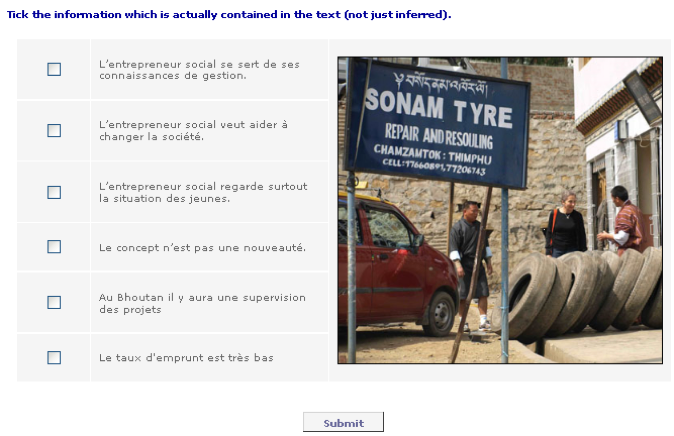
A Journey Through Online
Language Learning

Activities > Reading
Things to consider
The language skill of reading can be practised relatively easily online, either as a component of a comprehensive language course or as a specific skills course, as in the case of the Business Dutch course, which teaches students with little starting knowledge of Dutch to read both business and financial Dutch texts.
Reading activities tend to be built around a reading text, which can be an authentic fragment from a literary text, newspaper or magazine or your own creations. Your choice may depend on copyright issues and the level of your students. It is a good idea to offer your students a glossary to accompany the reading text or scroll-over/pop-up word explanations and/or English translations (example from Hogelands).
The reading activities can be self-correcting or tutor-supported, and often focus on vocabulary and content. Vocabulary exercises are usually self-correcting, and test students’ knowledge and understanding of the new vocabulary in the text . Self-correcting vocabulary exercises include gap-fill exercises (example from Lagelands), drag-and-drop exercises (example from Hogelands), true/false exercises (example from Read Ukrainian), matching exercises and selecting exercises (example from Lagelands).

Example of a self-correcting reading activity in Task Chains (French).
This type of exercise can be easily developed using freeware such as Hot Potatoes, and is most appropriate for testing beginners’ knowledge. Tutor-supported vocabulary activities can be developed for all levels, but are particularly useful in materials for intermediate and advanced learners when more idiomatic levels of the language may be tested. Example exercises include detailed word-analysis, re-using new vocabulary, etc. Some of these activities may also teach their students transferable skills. Exercises testing students’ understanding of the content of texts can be self-correcting or tutor-supported and developed for all levels. Activities range from making summaries or translations, to answering specific questions on the content of the text (example from Business Dutch).
- How will the materials/course be delivered? Will the activities be part of a blended learning context or wholly online? Will some of the activities be done in a face-to-face context or not? Will feedback be provided online or in a classroom?
- What type of course do you want to offer? Will the activities be part of a comprehensive language course or will they be offered as a specific skills course focusing on developing (only) reading skills?
- What are the learning outcomes of the activities? What do you want your students to take away? What do you want your students to practise themselves? What will be the focus of the activities?
- How much support can you or are you willing to offer as a tutor? This will influence the balance between the number of self-correcting
versus tutor-supported activities.
- Will the activities be assessed? How do you want to assess them?
- How much (technical) support do you have to develop the activities? What is your own technical know-how? Self-correcting reading activities can be developed using freeware or be web-based, but they require a more advanced technical knowledge on the part of the developer than tutor-supported reading activities that allow students to simply email their answers for the tutor for feedback.
Examples:
- Reading Skills Course in Business Dutch
- Read Ukrainian
- Reading activities in Lagelands and Hogelands
- Task Chains
Disclaimer I Freedom of Information I Accessibility I Contact Us
University College London, Gower Street, London, WC1E 6BT Tel: +44 (0) 20 7679 2000
© UCL 1999–2011